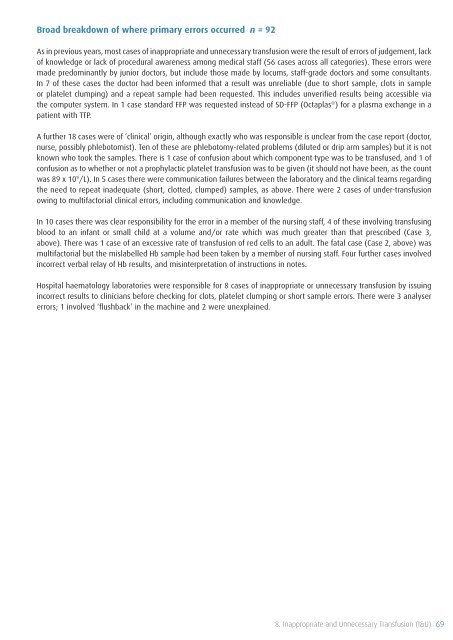SHOT Annual Report 2009 - Serious Hazards of Transfusion
SHOT Annual Report 2009 - Serious Hazards of Transfusion
SHOT Annual Report 2009 - Serious Hazards of Transfusion
Create successful ePaper yourself
Turn your PDF publications into a flip-book with our unique Google optimized e-Paper software.
Broad breakdown <strong>of</strong> where primary errors occurred n = 92<br />
As in previous years, most cases <strong>of</strong> inappropriate and unnecessary transfusion were the result <strong>of</strong> errors <strong>of</strong> judgement, lack<br />
<strong>of</strong> knowledge or lack <strong>of</strong> procedural awareness among medical staff (56 cases across all categories). These errors were<br />
made predominantly by junior doctors, but include those made by locums, staff-grade doctors and some consultants.<br />
In 7 <strong>of</strong> these cases the doctor had been informed that a result was unreliable (due to short sample, clots in sample<br />
or platelet clumping) and a repeat sample had been requested. This includes unverified results being accessible via<br />
the computer system. In 1 case standard FFP was requested instead <strong>of</strong> SD-FFP (Octaplas ® ) for a plasma exchange in a<br />
patient with TTP.<br />
A further 18 cases were <strong>of</strong> ‘clinical’ origin, although exactly who was responsible is unclear from the case report (doctor,<br />
nurse, possibly phlebotomist). Ten <strong>of</strong> these are phlebotomy-related problems (diluted or drip arm samples) but it is not<br />
known who took the samples. There is 1 case <strong>of</strong> confusion about which component type was to be transfused, and 1 <strong>of</strong><br />
confusion as to whether or not a prophylactic platelet transfusion was to be given (it should not have been, as the count<br />
was 89 x 10 9 /L). In 5 cases there were communication failures between the laboratory and the clinical teams regarding<br />
the need to repeat inadequate (short, clotted, clumped) samples, as above. There were 2 cases <strong>of</strong> under-transfusion<br />
owing to multifactorial clinical errors, including communication and knowledge.<br />
In 10 cases there was clear responsibility for the error in a member <strong>of</strong> the nursing staff, 4 <strong>of</strong> these involving transfusing<br />
blood to an infant or small child at a volume and/or rate which was much greater than that prescribed (Case 3,<br />
above). There was 1 case <strong>of</strong> an excessive rate <strong>of</strong> transfusion <strong>of</strong> red cells to an adult. The fatal case (Case 2, above) was<br />
multifactorial but the mislabelled Hb sample had been taken by a member <strong>of</strong> nursing staff. Four further cases involved<br />
incorrect verbal relay <strong>of</strong> Hb results, and misinterpretation <strong>of</strong> instructions in notes.<br />
Hospital haematology laboratories were responsible for 8 cases <strong>of</strong> inappropriate or unnecessary transfusion by issuing<br />
incorrect results to clinicians before checking for clots, platelet clumping or short sample errors. There were 3 analyser<br />
errors; 1 involved ‘flushback’ in the machine and 2 were unexplained.<br />
8. Inappropriate and Unnecessary <strong>Transfusion</strong> (I&U) 69












